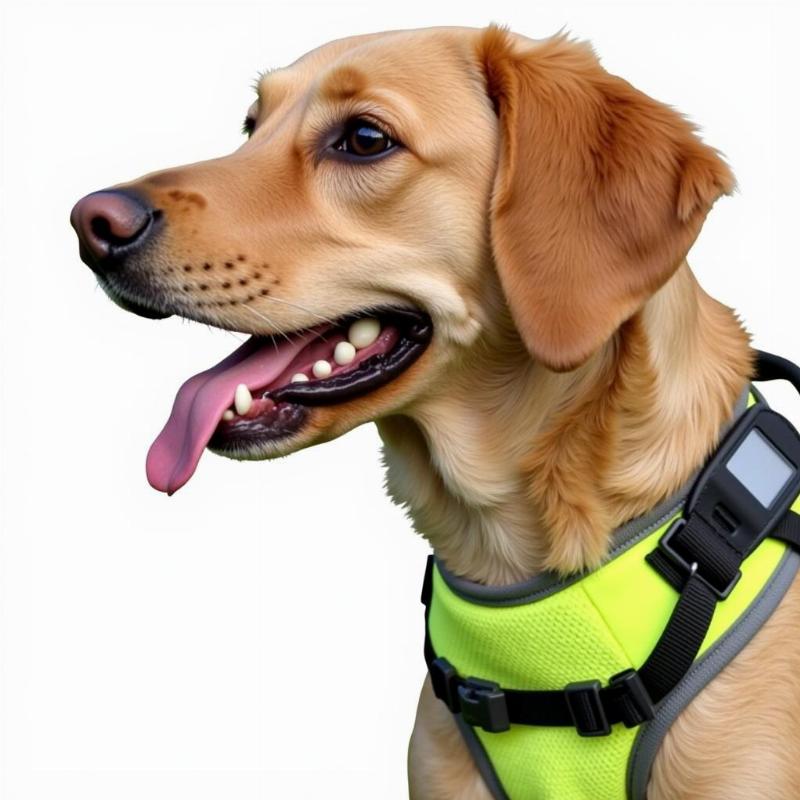Choke free harnesses are becoming increasingly popular with dog owners in the US, offering a more humane and comfortable way to walk their furry friends. If you’re considering a choke free harness for your dog, this guide will cover everything you need to know, from choosing the right type to proper fitting and training techniques.
Types of Choke Free Harnesses
Several types of choke free harnesses are available, each with its own advantages and disadvantages. Understanding the differences will help you select the best fit for your dog’s breed, size, and temperament.
Front-Clip Harnesses
Front-clip harnesses attach to the leash on the dog’s chest. This design helps redirect the dog’s forward momentum if they pull, gently discouraging pulling behavior. These harnesses are particularly effective for puppies and smaller dogs.
Back-Clip Harnesses
Back-clip harnesses attach to the leash on the dog’s back. These are generally easier for dogs to adjust to and are suitable for dogs who walk well on a leash. However, they offer less control for strong pullers.
Dual-Clip Harnesses
Dual-clip harnesses offer the flexibility of both front and back leash attachments. This versatility allows you to tailor the harness to different walking situations and training needs.
Choosing the Right Choke Free Harness for Your Dog
Consider the following factors when selecting a choke free harness:
- Breed and Size: Certain harnesses are better suited for specific breeds. For example, a deep-chested dog might benefit from a harness designed to prevent slippage.
- Pulling Tendencies: If your dog is a strong puller, a front-clip or dual-clip harness may be more effective.
- Activity Level: For highly active dogs, a durable and secure harness with reinforced stitching is crucial.
- Material and Comfort: Opt for breathable and padded materials, especially for dogs with sensitive skin.
Fitting a Choke Free Harness
A properly fitted harness is essential for your dog’s comfort and safety. Make sure the harness is snug but not too tight. You should be able to fit two fingers between the harness and your dog’s body.
Adjusting the Straps
Most choke free harnesses have adjustable straps around the chest and girth. Carefully adjust these straps to ensure a secure and comfortable fit.
Checking for Chafing
After fitting the harness, monitor your dog for any signs of chafing or discomfort, especially around the armpits and neck.
 Dog wearing a choke-free harness
Dog wearing a choke-free harness
Introducing Your Dog to a Choke Free Harness
Introducing the harness gradually will help your dog associate it with positive experiences.
- Positive Reinforcement: Use treats and praise to reward your dog for wearing the harness.
- Short Training Sessions: Start with short walks using the harness, gradually increasing the duration as your dog becomes more comfortable.
- Consistency: Use the harness consistently for all walks to reinforce positive associations.
Benefits of Using a Choke Free Harness
- Improved Safety: Choke free harnesses eliminate the risk of choking or tracheal damage associated with traditional collars.
- Enhanced Comfort: The padded design of most choke free harnesses provides a more comfortable walking experience.
- Better Control: Certain harness designs, such as front-clip harnesses, can assist in managing pulling behavior.
- Reduced Strain on Neck and Spine: Choke free harnesses distribute pressure evenly across the chest and back, reducing strain on the neck and spine.
Conclusion
A choke free harness is a valuable investment for any dog owner. By choosing the right harness, fitting it correctly, and introducing it gradually, you can ensure comfortable and enjoyable walks for both you and your furry friend. Remember to prioritize your dog’s well-being and consult with a veterinarian or professional dog trainer if you have any concerns.
FAQ
- What is the best choke free harness for a puppy? Front-clip harnesses are generally recommended for puppies as they help discourage pulling.
- How tight should a choke free harness be? You should be able to fit two fingers between the harness and your dog’s body.
- Can I use a choke free harness for running with my dog? Yes, many choke free harnesses are suitable for running, but ensure it’s secure and comfortable for your dog’s activity level.
- How do I clean a choke free harness? Most harnesses can be hand-washed or machine-washed on a gentle cycle. Check the manufacturer’s instructions.
- Are choke free harnesses suitable for all breeds? Yes, but certain breeds with specific body shapes may require specialized harnesses.
- What is the difference between a no-pull harness and a choke free harness? While all no-pull harnesses are choke free, not all choke free harnesses are designed specifically for no-pull training. No-pull harnesses typically utilize front-clip attachments to discourage pulling.
- Where can I buy a choke free harness? Choke free harnesses are widely available at pet stores, online retailers, and veterinary clinics.
Beautdogs.us is your premier source for expert dog care advice, breed information, and top-quality products. We’re dedicated to providing reliable information for both new and experienced dog owners. Our team of experts understands the nuances of dog ownership in the USA, and we strive to create content that resonates with American dog lovers. For further assistance, reach out to us at [email protected] or call +1 501-555-7529. Visit Beautdogs.us for more information.